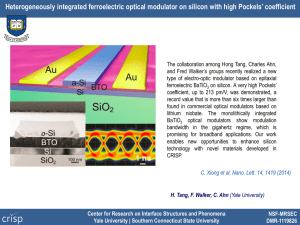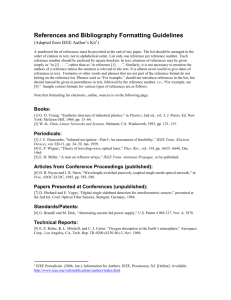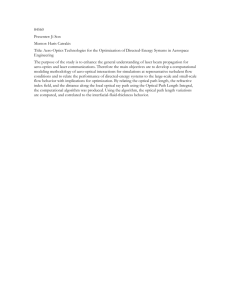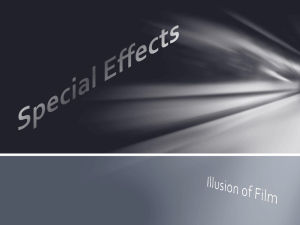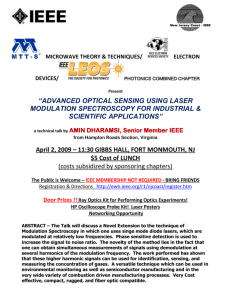Return-to-zero modulator using a single NRZ drive signal and an
advertisement
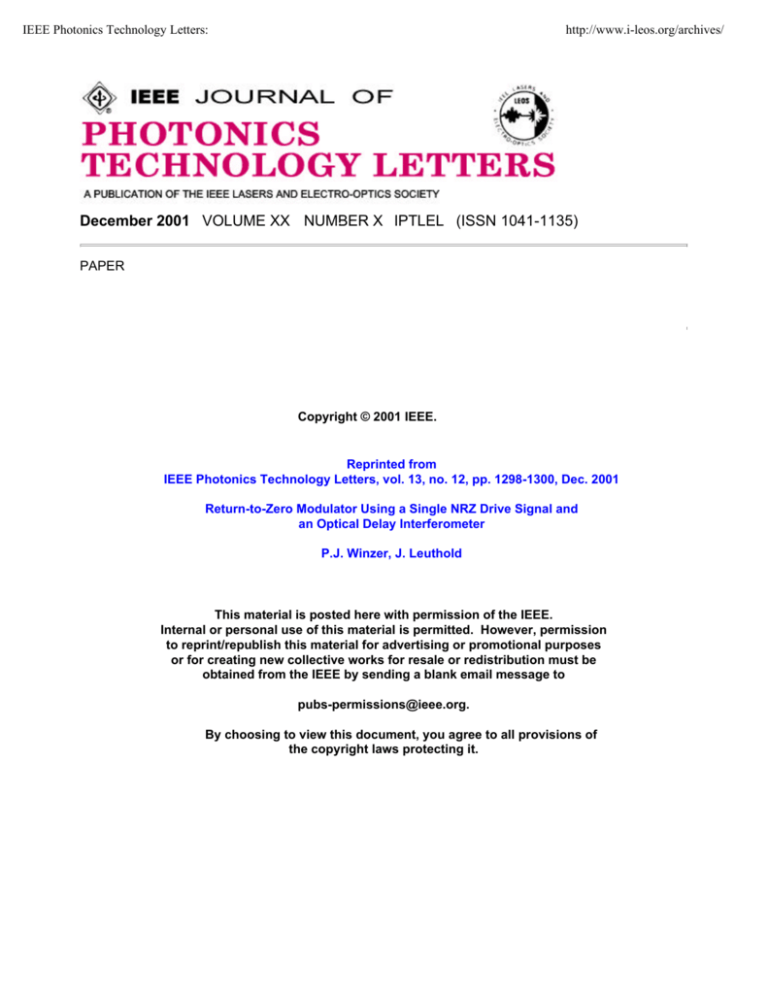
IEEE Photonics Technology Letters: http://www.i-leos.org/archives/ December 2001 VOLUME XX NUMBER X IPTLEL (ISSN 1041-1135) PAPER Copyright © 2001 IEEE. Reprinted from IEEE Photonics Technology Letters, vol. 13, no. 12, pp. 1298-1300, Dec. 2001 Return-to-Zero Modulator Using a Single NRZ Drive Signal and an Optical Delay Interferometer P.J. Winzer, J. Leuthold This material is posted here with permission of the IEEE. Internal or personal use of this material is permitted. However, permission to reprint/republish this material for advertising or promotional purposes or for creating new collective works for resale or redistribution must be obtained from the IEEE by sending a blank email message to pubs-permissions@ieee.org. By choosing to view this document, you agree to all provisions of the copyright laws protecting it. 1298 IEEE PHOTONICS TECHNOLOGY LETTERS, VOL. 13, NO. 12, DECEMBER 2001 Return-to-Zero Modulator Using a Single NRZ Drive Signal and an Optical Delay Interferometer Peter J. Winzer and Juerg Leuthold Abstract—In this letter, we experimentally demonstrate and discuss a new technique for variable duty cycle return-to-zero (RZ) modulation, employing a phase modulator driven by a single electrical nonreturn-to-zero signal, and an optical delay interferometer. Unlike other methods for generating RZ, no synchronization between two electrical driving signals is needed. Index Terms—Delay lines, modulation, optical communication, optical pulse generation, optical transmitters. I. INTRODUCTION Fig. 1. Block diagram of RZ source. O PTICAL RETURN-TO-ZERO (RZ) signals are becoming increasingly important in optical communication systems. They have proven to be superior to the nonreturn-to-zero (NRZ) format both in terms of receiver sensitivity [1]–[4], and in terms of fiber transmission performance [5]–[7]. The two most commonly used techniques to generate optical RZ data streams either employ a sinusoidally driven intensity modulator or an actively mode-locked laser [8]–[10] in addition to a NRZ data modulator. Apart from the need for two or more high-power RF components, these techniques necessitate accurate synchronization between the data modulator and the pulse source. Two less frequently used techniques make use of electrical RZ generation by means of gating the NRZ clock with the NRZ data signal [11], which necessitates high modulation bandwidths, however, or drive a Mach–Zehnder intensity modulator with the NRZ data between its transmission minima [12], with the drawback of having to use exactly twice the modulator’s maximum-to-minimum transmission drive voltage V for good extinction performance. In this letter, we discuss and experimentally demonstrate a new scheme for RZ generation using a single, NRZ-driven phase modulator followed by a (passive) optical delay interferometer. This technique eliminates the need for any synchronization between two signals, and considerably alleviates the requirements on the driver amplifiers. While under review, the method described in this letter has been independently proposed by another group [13], who interpret the resulting modulation format as duobinary, carrier-suppressed RZ (DCS-RZ). Our in-depth discussion in Section II will yield more insight into the properties of the modulation format and show that a DCS-RZ format is only obtained under the assumption of very high bandwidth modulator driving, or by using a dual-drive Mach–Zehnder modulator (MZM) for phase modulation [15]. Manuscript received July 9, 2001; revised August 21, 2001. The authors are with Bell Laboratories, Lucent Technologies, Holmdel, NJ 07733 USA (e-mail: peter.winzer@ieee.org). Publisher Item Identifier S 1041-1135(01)09971-2. II. PRINCIPLE OF OPERATION AND SIMULATION A block diagram of the transmitter is shown in Fig. 1. The light from a continuous-wave (CW) laser source is first passed through a phase modulator that is driven by the differentially encoded NRZ data signal, which exhibits a change in its logic level for each logical “1” bit to be sent; differential encoding can be done entirely in the digital domain using a one bit delay feedback and an exclusive or (XOR) gate [14]. The subsequent (passive) optical delay interferometer, which is adjusted for destructive interference in the absence of optical phase changes, then converts the NRZ phase modulation into RZ pulses with a width corresponding to the optical delay. Fig. 2 visualizes the (simulated) waveforms at various points within the setup. The binary signal to be transmitted in RZ format is shown in (a). Its differentially encoded version, whose low-pass filtered edges take into account finite-bandwidth driving electronics, is given in (b). The phases of the two interfering signals at the output of the interferometer are shown as solid and dashed lines in (c). As indicated in (d), any phase difference between the two arms gives rise to an RZ pulse with of a complex field envelope (1) denotes the differentially encoded, elecwhere trical NRZ driving voltage normalized to V (the voltage necessary for a phase shift of ), stands for the interferometer’s takes into account any deviation from destrucdelay, and tive interference in the absence of phase modulation. The (field) splitting ratios of the interferometer’s two splitters are denoted s and s ; their squares represent the fractions of the splitters’ 1041–1135/01$10.00 © 2001 IEEE WINZER AND LEUTHOLD: RETURN-TO-ZERO MODULATOR 1299 Fig. 3. The spectrum E (f ) of the RZ optical field e(t) is made up of two components that are frequency shifted relative to the optical carrier. Fig. 2. Principle of operation. (a) The data to be cast into RZ form is differentially encoded, and (b) amplified by band-limited RF driving electronics. (c) At the output coupler of the delay interferometer, two fields with delayed phases are superimposed, giving rise to RZ pulses (d) with phases shown in (e). input powers that are coupled from their inputs to one of their outputs. Note that the achievable extinction ratio is primarily determined by the interferometer’s ability to produce destructive interference, which depends on setting the splitting ratios equal, and on tuning for destructive interference, but not on dynamic features, such as achieving an exact amount of drive voltage swing (which is a critical issue in a similar technique described most importantly influences the in [12]). The maximum of insertion loss of the device, since it determines the degree of achievable constructive interference. (For example, if the available drive voltage swing amounts to only V /2, we find an additional 3-dB insertion loss.) The phase of the modulated optical field, as calculated from , (1) with ideal interferometer parameters and i.e., with a phase modulator drive voltage swing of V , is shown in Fig. 2(e). Note that there are two differently shaped phase transitions between adjacent RZ pulses, which is a direct consequence of the first term in (1), characterizing basically the output optical field’s phase, while the phase rises by during each leading edge of the differentially encoded NRZ seduring each trailing edge. The quence, it falls by phase jumps at the beginning of an RZ pulse represent changes caused by the term in brackets in (1). For in the sign of high bandwidth (nearly rectangular) driving of the phase modulator with V , the phase transitions occur instantaneously at the beginning of a pulse, leading to a duobinary type of RZ format [13]. A duobinary-like format is also acheived using a dual-drive MZM for phase modualtion [13], [15]; this inherently leads to instantaneous phase shifts, independent of the drive bandwidth, but at the cost of an additional drive signal, and consequently, the need for temporal alignment of two RF signals. Fig. 4. Optical eye diagram recorded from 2 delay was 100 ps, leading to 25% RZ duty cycle. 0 1 PRBS at 2.5 Gb/s. The Due to the different slopes of two adjacent RZ pulses’ phase waveforms, the center frequency of every other RZ pulse is shifted toward a different direction relative to the unmodulated carrier, which influences the spectrum of the RZ sequence Fig. 3 shows the simulated absolute magnitude of the spectrum of resulting from a 2 PRBS (solid). As expected from the phases of the RZ pulses, the spectral envelope is given by a superposition of the spectrum of a single downshifted pulse (dashed) and that of a single upshifted pulse (dotted). The amount of this frequency shift (and thus, the overall spectral width of the RZ signal) is determined mostly by the drive voltage swing. In general, low drive voltages produce less frequency shift, and thus, narrower RZ spectra. In Fig. 3, we . assumed III. EXPERIMENTAL DEMONSTRATION For an experimental demonstration at a data rate of 2.5 Gb/s, we used a CW semiconductor laser operating in the 1550-nm wavelength range, a LiNbO phase modulator, and a delay interferometer with 100-ps optical delay. In the absence of phase modulation, the interferometer was tuned for maximum destructive interference at the laser wavelength by means of a current-tunable phase section in one of its arms, which led to a 1300 IEEE PHOTONICS TECHNOLOGY LETTERS, VOL. 13, NO. 12, DECEMBER 2001 sitivity of 40 dBm could be obtained for RZ, showing 2-dB sensitivity gain over NRZ. IV. CONCLUSION We have discussed and experimentally demonstrated a new method of generating optical RZ signals using a single, NRZ driven phase modulator in combination with a passive optical delay interferometer. The technique does not require synchronization of two electrical drive signals. ACKNOWLEDGMENT 0 Fig. 5. Measured heterodyned spectrum of a 2 1 PRBS at 2.5 Gb/s with 100-ps delay (black) and simulation according to (1) (gray). The authors would like to thank J. F. Bailey, K. H. Bogart, M. A. Cappuzzo, L. T. Gomez, R. W. Long, S. Patel, E. J. Laskowski, A. E. White, and L. W. Stultz for manufacturing the delay interferometer. Also, A. H. Gnauck, M. Zirngibl, and G. Raybon are acknowledged for valuable discussions. REFERENCES Fig. 6. BER for the proposed RZ modulation scheme (circles) and NRZ baseline (rectangles) measured at with an optically preamplified receiver. The amounts to 40 dBm, showing a gain of 2 dB sensitivity for BER = 10 over NRZ. 0 (static) extinction ratio of 20 dB. The measured optical eye diPRBS is shown in Fig. 4, agram corresponding to a 2 yielding a RZ duty cycle of 25%, as expected for the chosen delay. The heterodyned spectrum of the optical field is shown in Fig. 5 (black), together with the results of a simulation (gray) , according to (1). The simulation parameters are describing imperfect coupling ratios of the interferometer’s two accounting for a slight phase mismatch at splitters the interferometer’s output arm, and a first-order RC low-pass filtered NRZ drive signal with a 3- dB bandwidth of 5 GHz and an amplitude of 0.5 V . The agreement between measurement and simulation is excellent. (The weights of the spectral lines at multiples of the data rate depend critically on the exact shape of the NRZ drive signal.) Note the presence of a line at the carrier frequency, which is not present in the idealized spectrum given in Fig. 3. This line is caused by imperfect balancing of the interferometer’s power splitters. Finally, Fig. 6 shows the results of a bit-error-ratio (BER) measurement taken with an optically preamplified receiver. The circles represent the performance of the proposed RZ modulation scheme, while the rectangles apply to NRZ, generated with , a receiver sena dual-drive LiNbO MZM. At BER [1] S. D. Personick, “Receiver design for digital fiber optic communication systems I,” Bell Syst. Tech. J., vol. 52, pp. 843–874, 1973. [2] L. Boivin, M. C. Nuss, J. Shah, D. A. B. Miller, and H. A. Haus, “Receiver sensitivity improvement by impulsive coding,” IEEE Photon. Technol. Lett., vol. 9, pp. 684–686, May 1997. [3] W. A. Atia and R. S. Bondurant, “Demonstration of return-to-zero signaling in both OOK and DPSK formats to improve receiver sensitivity in an optically preamplified receiver,” in Proc. IEEE LEOS’99, paper TuM3. [4] P. J. Winzer and A. Kalmar, “Sensitivity enhancement of optical receivers by impulsive coding,” J. Lightwave Technol., vol. 17, pp. 171–177, Feb. 1999. [5] D. Breuer and K. Petermann, “Comparison of NRZ- and RZ-modulation format for 40-Gb/s TDM standard-fiber systems,” IEEE Photon. Technol. Lett., vol. 9, pp. 398–400, Mar. 1997. [6] R. Ludwig, U. Feiste, E. Dietrich, H. G. Weber, D. Breuer, M. Martin, and F. Kuppers, “Experimental comparison of 40 Gbit/s RZ and NRZ transmission over standard singlemode fiber,” Electron. Lett., vol. 35, no. 25, pp. 2216–2218, 1999. [7] C. Caspar et al., “RZ versus NRZ modulation format for dispersion compensated SMF-based 10-Gb/s transmission with more than 100-km amplifier spacing,” IEEE Photon. Technol. Lett., vol. 11, pp. 481–483, Apr. 1999. [8] A. Ougazzaden et al., “40 Gb/s tandem electro-absorption modulator,” in Proc. OFC’01, 2001, Postdeadline paper PD14. [9] R. A. Griffin, R. G. Walker, R. I. Johnstone, R. Harris, N. M. B. Perney, N. D. Whitbread, T. Widdowson, and P. Harper, “Integrated 10 Gb/s chirped return-to-zero transmitter using GaAs/AlGaAs modulators,” in Proc. OFC’01, 2001, Postdeadline paper PD15. [10] H. Suche, A. Greiner, W. Qiu, R. Wessel, and W. Sohler, “Integrated optical Ti : Er : LiNbO3 soliton source,” IEEE J. Quantum Electron., vol. 33, pp. 1642–1646, Oct. 1997. [11] N. M. Froberg et al., “Generation of 12.5 Gbit/s soliton data stream with an integrated laser-modulator transmitter,” Electron. Lett., vol. 30, no. 22, pp. 1880–1881, 1994. [12] J. J. Veselka, S. K. Korotky, P. V. Mamyshev, A. H. Gnauck, G. Raybon, and N. M. Froberg, “A soliton transmitter using a cw laser and an NRZ driven Mach–Zehnder modulator,” IEEE Photon. Technol. Lett., vol. 8, pp. 950–952, July 1996. [13] Y. Miyamoto, A. Hirano, S. Kuwahara, Y. Tada, H. Masuda, S. Aozasa, K. Murata, and H. Miyazawa, “S-band 3 120-km DSF transmission of 8 42.7-Gbit/s DWDM duobinary-carrier-suppressed RZ signals generated by novel wideband PM/AM conversion,” in Proc. Optical Amplifiers and Their Applications (OAA’01), 2001, Postdeadline paper PD6. [14] E. A. Lee and D. G. Messerschmitt, Digital Communication, 2nd ed. New York: Kluwer Academic Publishers, 1994. [15] T. Chikama, S. Watanabe, T. Naito, H. Onaka, T. Kiyonaga, Y. Onoda, H. Miyata, M. Suyama, M. Seino, and H. Kuwahara, “Modulation and demodulation techniques in optical heterodyne PSK transmission systems,” J. Lightwave Technol., vol. 8, pp. 309–322, Mar. 1990. 2 2
